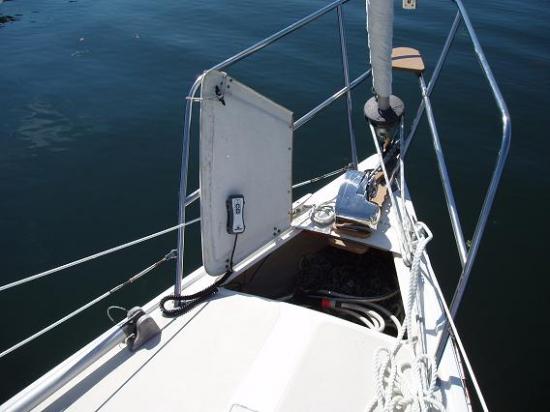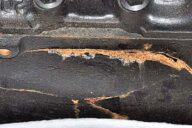Here’s another great tip from our friend Capt. John from skippertips.com…
You enter the narrow 50 yard wide channel between the jetties under power. A brisk cross-channel wind and current make steering a challenge. All of a sudden at the worst possible moment–your engine sputters and dies! Desperate now, you lean down and push the starter button–nothing doing. You send your sailing partner forward to get the anchor over the side. Your partner yells back that the anchor line has tangled and jammed! The jetty rocks to port–like a Great White’s gaping mouth–loom closer and closer…
Is your sailboat anchor and her ground tackle ready to deploy in ten seconds or less? In an emergency that might be how long you have to get it down and get it set!
Paper or Metal Insurance Policy?
Forget about paper insurance policies. When you need insurance nothing beats a well tested boat anchor to keep you from disaster. But there’s a lot more to it than that. Without the proper ground tackle–all the parts of the umbilical cord between the boat and the anchor–your anchor might as well be down below in the cabin.
Consider that in an emergency, you may have just ten seconds to get your anchor over the side. Let’s put this into play and see what would happen to our boat in the opening scenario in just ten seconds…
If you consider drift rate–at just 2 knots of current (“current” in navigation is considered the combination of all forces that affect the drift of the boat; i.e. wind, current, steering), your boat will drift about 11 yards (10 meters) every ten seconds. In the opening scenario, you would be on the rocks in less than 25 seconds if you drifted at 2 knots from mid-channel (our channel was just 50 yards wide from jetty to jetty).
Preparation holds the key to success in most every emergency. Make this seven-point anchor inspection standard operating procedure (SOP) aboard your sailboat. Add it to your “pre-sail” check-off sheet. That way, you will be ready for the unexpected.
1. Look for a Straight Anchor Shank
If the anchor stows in an anchor roller, the shank (long arm of the anchor) could bend if it snags on a piling. Do not attempt to use an anchor with a bent shank. Replace the entire anchor right away! To check your an anchor shank, straddle the anchor shank and look straight down. Check the alignment between shank and flukes. Make sure that you see no distortion.
2. Insure Anchor Shackle Integrity
Make sure the shackle at the ring holds the anchor rode securely. Secure the shackle pin to the shackle side with stainless seizing wire or a plastic wire tie. At the end of each sailing season, remove the seizing, unscrew the shackle pin, wire brush the shackle pin and shackle body threads, and clean the shackle of corroded crud or salt. Reassemble the parts and install a new seizing or nylon wire tie. Now your anchor shackle will be ready to roll next season.
3. Inspect the Anchor Chain
Chain length should equal the length of the boat, or close to it. Check all along the chain for distortion, rust or corrosion. Follow step 2 to secure the shackle that joins chain to rope. If you use all-chain anchor rode, you need to inspect entire rode at the end of each sailing season or before you depart on a lengthy cruise or voyage. This will give you peace-of-mind that your chain will serve you without a hitch in any anchorage you choose.
4. Make Ready Ten Fathoms of Rope Rode
Physically pull out at least ten fathoms (1 fathom = 6 feet) of rope rode from the locker. As you pull out the rode, stretch both arms straight out from your side–that equals six feet. Do it ten times and you have ten fathoms. Drop the rope rode onto the deck as you pull out the rode. Go to the next step.
5. Check Rope Rode for Chafe
Check all along the rope rode for chafe, wear or weakness. Some minor abrasion on the outer surface can be expected in spots. Make a note in your maintenance log of where these minor spots are along the rode. That way, you can keep keep an eye on them throughout the sailing season. Do not use rode that shows anything other than slight surface chafe.
6. Secure the Rode to the Boat
Dig under the coil inside the locker. Find the bitter end and make sure it’s tied to the eye bolt with a proper bowline.
7. Coil Your Anchor Rode “Kink-Free”
Coil the ten fathoms of rope rode, clockwise, back down into the locker. Make sure you start at the end closest to the anchor locker. The way you coil depends on whether you use three-strand or double-braided rope anchor rode. With three-strand line, twist your wrist clockwise ¼ turn away from you as you coil. This keeps kinks and hockles (twists) out of the coils. With double-braided line, coil without the “wrist twist”. Double-braided coils often take on a figure-8 shape as they stack on top of one another. Allow the double-braided line to take on this natural shape as you coil.
~~~~~~~~~~~~~~~~~~~~
Use these seven sailboat anchoring sailing tips to be prepared to set your anchor in ten seconds or less. Sail with the peace-of-mind and confidence that your boat and crew will be protected in most any circumstance–wherever in the world you choose to sail or cruise!












